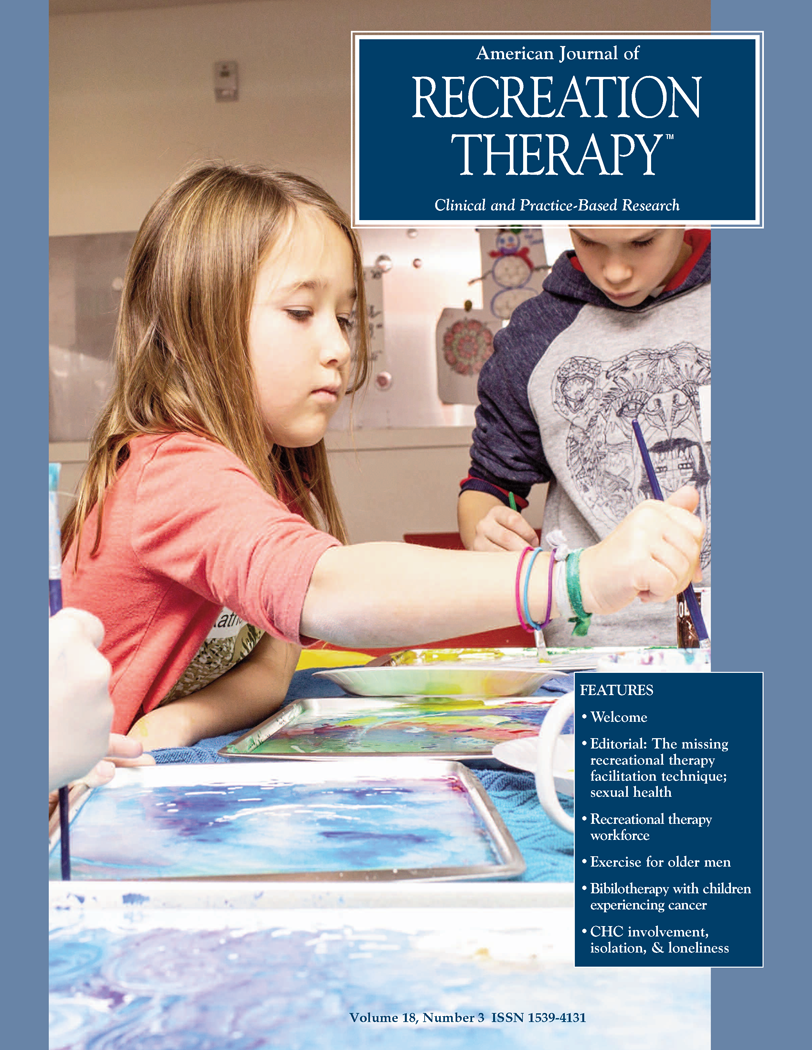The conundrum of exercise for older men in TR settings
DOI:
https://doi.org/10.5055/ajrt.2019.0192Keywords:
exercise, motives, older men, physical activity, walkingAbstract
The purposes of this study were to determine how older men distinguished exercise from being physically active and to identify motives for exercising. Subjects were interviewed using a prepared script. They were encouraged to talk about how they characterized their exercise and physical activity (PA). Several themes emerged after transcripts were reviewed, including a tendency for men to engage in PA and exercise alone, a clear distinction between exercise and PA, and the primacy of psychological and mental benefits as motives for exercise. Comparisons were drawn between the male subjects in the present study and qualitative studies using older women as subjects, with some interesting gender contrasts apparent. The article ends with implications for practitioners.
References
Centers for Disease Control and Prevention (CDC): Current physical activity guidelines. Available at https://www.cdc.gov/cancer/dcpc/prevention/policies_practices/physical_activity/guidelines.htm. Accessed May 4, 2018.
Garatachea N, Molinero O, Martínez-García R, et al.: Feelings of well being in elderly people: Relationship to physical activity and physical function. Arch Gerontol Geriatr. 2009; 48(3): 306-312.
Mobily KE: Role of exercise and physical activity in therapeutic recreation services. Ther Recreat J. 2009; 43: 9-26.
Franco MR, Tong A, Howard K, et al.: Older people’s perspectives on participation in physical activity: A systematic review and thematic synthesis of qualitative literature. Br J Sports Med. 2015; 49: 1268-1276.
Mobily KE, Smith AK, Chmielewski KS: Work, retirement and working out: The construction of organized exercise and the social world of retired women. Ann Leis Res. 2017; 20(3): 273-294.
Moschny A, Platen P, Klaaben-Mielke R, et al.: Physical activity patterns in older men and women in Germany: A cross-sectional study. BMC Public Health. 2011; 11: 559-567.
Devereux-Fitzgerald A, Powell R, Dewhurst A, et al.: The acceptability of physical activity interventions to older adults: A systematic review and meta-analysis. Soc Sci Med. 2016; 158: 14-23. doi:10.1016/j.socscimed.2016.04.006.
Jurj AL, Wanqing W, Gao Y-T, et al.: Patterns and correlates of physical activity: A cross-sectional study in urban Chinese women. BMC Public Health. 2007; 7: 213-224.
Lawlor DA, Taylor M, Bedford C, et al.: Is housework good for health? Levels of physical activity and factors associated with activity in elderly women. J Epidemiol Commun Health. 2002; 56: 473-478.
Steffan LM, Arnett DK, Blackburn H, et al.: Population trends in leisure-time physical activity: Minnesota heart survey, 1980–2000. Med Sci Sports Exerc. 2006; 38(10): 1716-1723.
Brown WJ, Burton NW, Sahlqvist S, et al.: Physical activity in three regional communities in Queensland. Aust J Rural Health. 2013; 21: 112-120.
Buckworth J, Dishman RK: Exercise adherence. In Tannenbaum G, Eklund RC (eds.): Handbook of Sport Psychology. 3rd ed. Hoboken, NJ: John Wiley & Sons, Inc., 2007: 509-536.
Kuptniratsaikul V, Tosayanonda O, Nilganuwong S, et al.: The epidemiology of osteoarthritis of the knee in elderly patients living in an urban area of Bangkok. J Med Assoc Thai. 2002; 85: 154-161.
Van Uffelen JGZ, Khan A, Burton NW: Gender differences in physical activity motivators and context preferences: A population-based study in people in their sixties. BMC Public Health. 2017; 17: 624-632.
De Lacy-Vawdon CJ, Klein R, Schwarzman J, et al.: Facilitators of attendance and adherence to group-based physical activity for older adults: A literature synthesis. J Aging Phys Act. 2018; 26(1): 155-167.
Grant BC: An insider’s view on physical activity in later life. Psychol Sport Exerc. 2008; 9: 817-829.
Jancey JM, Clarke A, Howat PA, et al.: A physical activity program to mobilize older people: A practical and sustainable approach. Gerontologist. 2008; 48(2): 251-257.
Kluge MA: Understanding the essence of a physically active lifestyle: A phenomenological study of women 65 and older. J Aging Phys Act. 2002; 10: 4-27.
Little A: Physical activity in the transitional phase of old age: A phenomenological investigation. J Aging Phys Act. 2012; 20(suppl): S61-S61.
Martin AM, Woods CB: What sustains long-term adherence to structured physical activity after a cardiac event? J Aging Phys Act. 2012; 20: 135-147.
O’Brien Cousins S: Seniors say the ‘Darndest’ things about exercise: Quotable quotes that stimulate applied gerontology. J Appl Gerontol. 2003; 22(3): 359-378.
O’Brien Cousins S, Vertinsky PA: Recapturing the physical activity experiences of the old: A study of three women. J Aging Phys Act. 1995; 3: 146-162.
Stead M, Wimbush E, Eadie D, et al.: A qualitative study of older people’s perceptions of ageing and exercise: The implications for health promotion. Health Educ J. 1997; 56(3): 3-16.
Trost SG, Owen N, Bauman AE, et al.: Correlates of adults’ participation in physical activity review and update. Med Sci Sport Exerc. 2002; 34: 1996-2001.
Mobily K, Lenartz A: Aquatic exercise among older adults: A qualitative investigation. Top Geriatr Rehabil. 2017; 33(3): 203-210.
Merriam SB: Qualitative Research: A Guide to Design and Implementation. San Francisco, CA: Jossey-Bass, 2009.
Atalay OT, Cavlak U: The impact of unsupervised regular walking on health: A sample of Turkish middle-aged and older adults. Eur Rev Aging Phys Act. 2011; 9(1): 71-79.
Newhall KE: Is this working out?: A spatial analysis of women in the gym. Iowa Research Online. Available at https://ir.uiowa.edu/cgi/viewcontent.cgi?article=4723&context=etd. Accessed May 4, 2018.
The Society for Cardiovascular Angiography and Interventions (SCAI): The difference between physical activity and exercise. Available at http://www.secondscount.org/heartresources/heart-resources-detail?cid=5aace514-1d21-431db91f-9f7fa35fc3ad&gclid=Cj0KCQjw8YXXBRDXARIsAMzsQuXF2b9WSMkinmkUjUiFRV-QJhVFFzA8DoyAfirFPSxeuSvCfn3ADOUaAvhVEALw_wcB#.WuVZQ9PwbOR. Accessed May 4, 2018.
Welmer AK, Morck A, Dahlin-Ivanoff S: Physical activity in people age 80 years and older as a means of counteracting disability, balanced in relation to frailty. J Aging Phys Act. 2012; 20: 317-331.
Vertinsky PA: ‘Run Jane, Run’: Central tensions in the current debate about enhancing women’s health through exercise. Women Health. 1997; 27(4): 81-111.
Hwang J, Wang L, Siever J, et al.: Loneliness and social isolation among older adults in a community exercise program: A qualitative study. Aging Mental Health. 2018; 12: 1-7.
Published
How to Cite
Issue
Section
License
Copyright 2000-2025, Weston Medical Publishing, LLC and American Journal of Recreation Therapy. All Rights Reserved.


